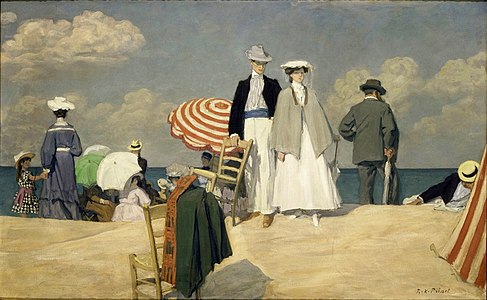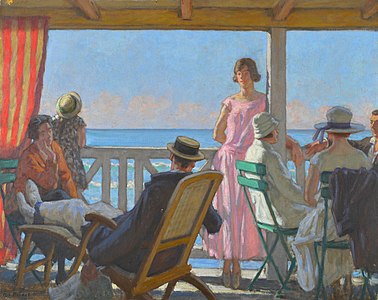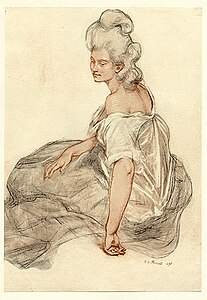|
René-Xavier Prinet
René François Xavier Prinet (31 December 1861, Vitry-le-François – 26 January 1946, Bourbonne-les-Bains) was a French painter and illustrator. BiographyBorn to a family of notables from Franche-Comté (the Prinet notaries originally from Luxeuil-les-Bains), René-Xavier Prinet was the son of Henry Prinet, born in 1824, imperial prosecutor in Vitry-le-François, and the brother of Gaston Prinet, diplomat. Appointed to Paris, Henry Prinet lived with his family on rue Bonaparte, a stone's throw from the École des beaux-arts, for which René-Xavier seemed to be destined. His father painted as a hobby and was supportive of his desire to study art, having him seek the advice of Louis Charles Timbal, a well-known church painter and friend of the family. Through his maternal grandmother, René-Xavier Prinet is related to the court painters Hubert Drouais (1699-1767) and François-Hubert Drouais (1727-1775).  Around 1880, he began his studies in earnest, in the studios of Jean-Léon Gérôme. He remained with the master until 1885. He then became friends with the Franche-Comté painters Georges and Lucien Griveau, and with his fellow students at the Beaux-Arts, Antonio de La Gandara, Louis-Auguste Girardot, Félix Desgranges and Jules-Alexis Muenier. This was followed by studies at the Académie Julian. His painting Jésus enfant was accepted for display at the Salon in 1885. He exhibited at this Salon until 1889. In 1891, he received a commission from the French State for the decoration of the Palais de la Légion d'Honneur: Les Quatre Saisons. His sketches were accepted. The same year, he exhibited in Paris at the Durand-Ruel gallery with Albert Besnard, Jules-Alexis Muenier and Henri Fantin-Latour. In 1894, René-Xavier Prinet married Jeanne Jaquemin (1865-1958), a native of Bourbonne-les-Bains, whose bust was made by Antoine Bourdelle in 1910, at La Madeleine, Paris. His parents-in-law, Auguste and Louise-Berthe, residents of Bourbonne-les-Bains and Paris, having built a villa on the seafront of Cabourg around 1870 called the Double Six chalet, he spent his summers there from that time. He then painted many pictures of the beach of the Normandy resort, then in full expansion. Only a few hundred meters separated the Grand Hôtel de Cabourg, where Marcel Proust resided during his many stays in the seaside town, from the Double Six. Although there is no formal proof that the two men met, it is clear that the atmosphere depicted by Prinet corresponds exactly to that described by Proust in his texts. Works by the painter would later regularly enrich exhibitions in homage to the writer.  At this time, he also became associated with a group of young artists known as the Bande Noire (Black Stripe), which included Lucien Simon, André Dauchez, Émile-René Ménard and Charles Cottet. In June 1899, he joined the Société nouvelle de peintres et de sculpteurs, with a first collective exhibition at the Galerie Georges Petit in Paris in March 1900. One of his best-known works, The Kreutzer Sonata, was exhibited in 1901 at the "L'Art français contemporain" exhibition in Stuttgart where it was sold to Luitpold, Prince Regent of Bavaria. He then began teaching with his friends Dauchez, Ménard, Cottet, Simon and Jacques Emile Blanche at the Académie de la Palette, but was not convinced by the seriousness of the course. The year 1904 saw the creation, with the same friends and Antoine Bourdelle, who taught sculpture classes, of the workshops at the Académie de la Grande Chaumière. Very quickly, Prinet regularly taught painting classes there. His student was the Australian-born artist Bessie Davidson (1879-1965), who produced most of her work in France and was strongly influenced by her time at the Grande Chaumière8. He probably taught there until 1929, when he became a professor at the Beaux-Arts in Paris, where he created and directed the workshop for female artists.[1] He notably had Simone Desprez as a student. He left the Beaux-Arts in 1931, having reached the age limit. Alongside his teaching, he continued his artistic career and gained notoriety. In 1909, he illustrated La Jeune Fille bien élevée by René Boylesve. Over the course of his career, he would illustrate works by Balzac, Pierre Loti, Anatole France and Henri Bataille; among many others.[2] In 1913, he was appointed Secretary for the Société Nationale des Beaux-Arts and travelled to the United States; serving on the jury for an exhibition at Carnegie Mellon University.  Prinet painted the reception of Albert Besnard at the Académie des Beaux-Arts in 1912. In 1916, he painted the artist Félix Desgranges in his family living room in Luxeuil-les-Bains in the company of the Bessie Davidson in a composition entitled Chez Desgranges. Prinet was too old in 1914 to be mobilized in the army, but the First World War still disrupted his activities and he got involved in the conflict. In 1915 he participated in the 62 illustrations of the National Album of the War, a partly retrospective review of the fighting to which his friends Lucien Simon, Albert Besnard and Emile René Ménard also contributed, as well as painters such as Claude Monet, Auguste Renoir and Edouard Vuillard. This work was an initiative of the Fraternité des Artistes, an association organizing support to mobilized artists and various charitable operations, closely linked to the administration of the Beaux-Arts. Prinet became a member of this committee in 1914 and remained so until 1927. In 1914-1919, he also managed the Puvis de Chavanes canteen for artists, while remaining a member of several artists' societies. In October 1916, Prinet's involvement in the conflict became more direct and official. The Ministry of War then called on non-mobilized artists as observers with the aim of creating a collection of works of art on the conflict. Prinet was selected for two of these observation missions and his participation in them is definitly proven. His first mission, from March 7 to April 1 of the next year, in which Lucien Simon also was part, was the second one launched by the ministry. He was then assigned to the Vosges army. During the second, from June 1 to 30 of the same year, he was assigned to the Noyon army. The expenses were on him, but for each of his missions the French State purchased some of his works. These were presented at exhibitions bringing together the production of the commissioned artists and were integrated into the War Museum. In addition with his artistic activities, Prinet was also a night watchman in one of the hospitals of the Union of Women of France in 1915-1917.  His last painting on the theme of war, produced after his missions, L'Absoute, is intended to be more symbolic and less descriptive. It was completed in 1919 and exhibited at the Société Nationale des Beaux-Arts. After the war in 1920, he exhibited with René Ménard, Lucien Simon, Edmond Aman-Jean and Albert Besnard at the first Salon of French Artists in Brussels. The same year, he exhibited again in Pittsburgh at the 21st exhibition. He illustrated Pierre Loti's book Roman d'un Spahi. He joined in the Besnards' "Sundays" on rue Guillaume-Tell, Paris, and in 1922, the sculptor Philippe Besnard asked him to be the godfather of his daughter Anne-Elisabeth. Six years later, in 1926, the Société Belfortaine des Beaux-Arts was created. It then organized major exhibitions every year until the Second World War at the Belfort museums, in which René-Xavier Prinet participated along with Georges Fréset, Jacques-Émile Blanche, Jean-Eugène Bersier, Raymond Legueult, Anders Osterlind, Henry de Waroquier, and Jules-Émile Zingg. It became one of his favorite exhibition venues.[3] He also exhibited in Langres alongside Georges Fréset, Jules Adler, and Jules-René Hervé. During this period, he was also very active in several artists' committees and societies, in which he exhibited and, above all, ensured a form of promotion of the arts, such as within the Permanent Committee of French Exhibitions Abroad. His work was also part of the painting event in the art competition at the 1932 Summer Olympics in Los Angeles.[4] In 1943, he was elected to the Académie des Beaux-Arts to fill the chair made vacant by the death of Jules-Alexis Muenier in 1942. In addition to painting, he wrote two texts, Initiation à la peinture, in 1935,[5] and Initiation au dessin. René-Xavier Prinet died in his house in Bourbonne-les-Bains on January 26, 1946. He is buried in the cemetery of this town, with his spouse Jeanne. The two had no children. Selected works
Exhibitions
His work in public collections
References
Further reading
External linksWikimedia Commons has media related to René-Xavier Prinet.
|
||||||||||||||||||











